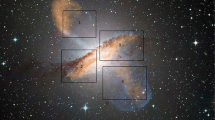Abstract
We have analysed an opportunity to form a predictive model for identifying the parameters of the Milky Way galaxy strands feather vector upon applying the theory of covariance functions. The strands of spiral galaxies are connected by narrower gas strips (referred to as feathers). We used the data on the gas strips connecting the first strands of the Milky Way galaxy to perform the calculations. A square cut-out of a photograph of the said strip in a jpg format was transformed into a textual form using the developed software. The Doppler method and the theory of covariance functions were applied to analyse the measurement data arrays. The trends of the feather intensity vector were evaluated by applying the least squares method. The said procedure helped partially eliminate the random errors of the performed measurements as well. Upon changing the intensity of the feather vector parameters on a time scale, the estimates of the autocovariance and cross-covariance of parameters of the vector were calculated while varying the quantisation interval on a time scale. The average values of the parameter z in the Doppler formula were calculated with the formula using the expressions of the cross-covariance functions of the algebraic addition of the relevant vectors and a single vector. The software used for the calculations was developed in the MATLAB packages.




Similar content being viewed by others
References
G Ciriako et al. Astronomical science, The Messenger 177 Quarter 25 (2019). https://doi.org/10.18727/0722-6691/5150
J Marianiuk and J Reda Publications of the Institute of geophysics, Polish Academy of Science, C-79 110 (2001)
A Czyszek and J Czyszek Publications of the Institute of geophysics, Polish Academy of Science, C-81 105 (2002)
B Tunga and A Koçanaoğulları Image and Video Process. 12 299 (2018).
S O X Chen et al Image and Video Process. 12 363 (2018).
Y Zheng et al. arXiv:1306.4383. (2013)
M A Nabian and H Meidani Computer Aided Civil and Infrastructure Engineering 33 443 (2018).
B Rubina J. Phys. 89 1077 (2015).
L M Martyushev and V D Seleznev Phys. Rep. 426 1 (2006).
A Belkin et al Sci. Rep. 5 8323 (2015).
F Albarède and J Blichert-Toft Comptes Rendus Geoscience 339 917 (2007).
H Kahmen Elektronische Messverfahren in der Geodäsie. Grundlagen und Anwendungen (Verlag Karsruhe: Weichmann) 252 (1978)
J Skeivalas, V Turla and M Jurevicius Indian J. of Phys. 93 1 (2019)
K R Koch Einführung in die Byes-Statistik (Springer-Verlag: Berlin Heidelberg) 225 (2012)
J Skeivalas et al Geodezija ir kartografija/Geodesy and cartography 34 88 (2008).
J Skeivalas GPS tinklų teorija ir praktika (Theory and Practice of GPS Networks) Vilnius Technika 288 (2008)
Author information
Authors and Affiliations
Corresponding author
Additional information
Publisher's Note
Springer Nature remains neutral with regard to jurisdictional claims in published maps and institutional affiliations.
Rights and permissions
Springer Nature or its licensor (e.g. a society or other partner) holds exclusive rights to this article under a publishing agreement with the author(s) or other rightsholder(s); author self-archiving of the accepted manuscript version of this article is solely governed by the terms of such publishing agreement and applicable law.
About this article
Cite this article
Skeivalas, J., Turla, V. The predictive model for identifying the parameters of the feather vector of Milky Way galaxy strands through applying the theory of covariance functions. Indian J Phys 97, 1673–1677 (2023). https://doi.org/10.1007/s12648-022-02535-5
Received:
Accepted:
Published:
Issue Date:
DOI: https://doi.org/10.1007/s12648-022-02535-5




